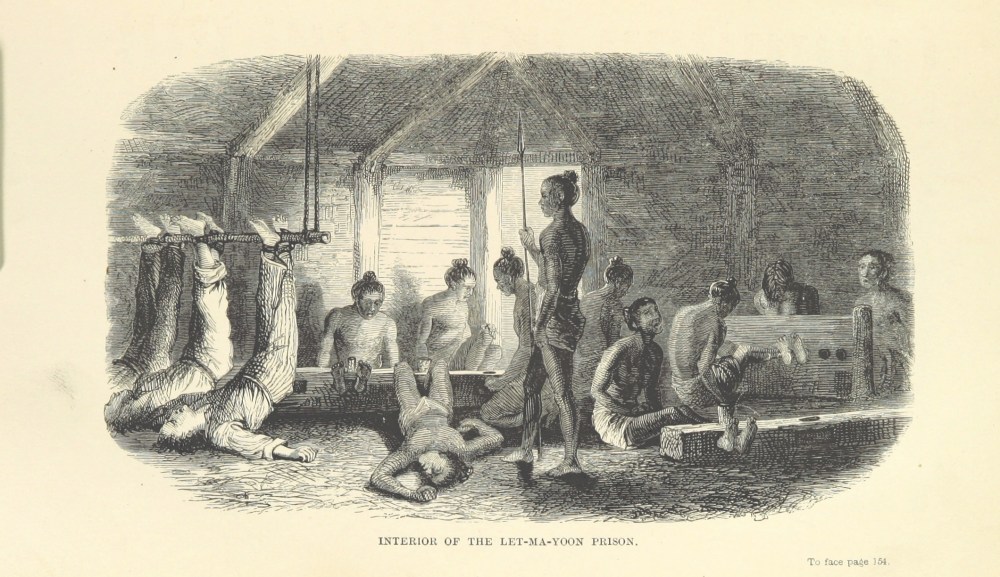The end of the teaching term last year coincided with the British Library releasing over one million images on their Flickr account. Making the most of this, I immediately began trawling through them to see what images of Burma I could find. Among the many I came across were two contrasting images of convicts.

This first picture was produced by Herny Gouger. He spent two years in a Burmese prison during the 1820s, when the country was still independent. It shows painful punishments being inflicted on convicts’ bodies. Images like these showing the cruelty of the Burmese regime towards convicts were widely circulated in Britain in the run up to the conquest of Burma. Drawings of bandits being crucified were published in the London Illustrated News in the months leading up to the last Anglo-Burmese War in 1885. Pictures showing convicts being subjected to physical torture were used to characterize the Burmese monarchy as tyrannical and brutal. Through pictures of punishment, like Gouger’s, Burma was being portrayed as a country in need of British rule.

This second image is a photograph of a group of convicts. It was taken in the 1890s, when British rule was firmly established. In contrast to Gouger’s drawing, these convicts are not shown in pain. They are still fettered, but the restraints do not seem to be causing any discomfort. Instead, the focus of this picture is the convicts themselves. And the Burmese convict was a source of considerable curiosity for British audiences. Following conquest, Burma was engulfed in widespread conflict. Buddhist monks, princes and social bandits rose up against the new imperial regime and waged guerrilla resistance. This conflict was well-documented in contemporary photographs. For decades after order had been restored in the 1890s, the colony had a reputation for high levels of violent crime. Pictures of captured Burmese ‘dacoits’ – a term that the British used indiscriminately for criminals, bandits and rebels – were used by colonial writers to draw attention to the supposed flaws in the Burmese character. Burmese men were routinely described by the British as being child-like in their impulsive, opportunistic criminality and their violent, short tempers.
These two images of convicts in nineteenth-century Burma made by British observers reflect the different times in which they were produced. Published before the country had been fully colonized, the first drew attention to the apparent cruelty of the pre-colonial Burmese state. Published following annexation, the second drew attention to the alleged criminality of the Burmese population itself. Both, however, served to justify colonial rule over the country. Michel Foucault argues that in early modern Europe criminal punishment shifted from forms of torture designed to inflict pain on the body, to systems of discipline that sought to reform the soul of the convict. What these images show is that this shift in forms of punishment was part of the rhetoric and visual culture of imperialism.
Sawaddee Ka(=Hello in Thai) My name is Nitar from Thailand. My major is Southeast Asian Studies and i have to do research for my senior year at university. I’m interested in ‘Colonial Burma’s prison’ so i read Ian Brown’s articles; ‘Death and Disease in the Prisons of Colonial Burma.’ ; ‘A Commissioner Calls: Alexander Paterson and Colonial Burma’s Prisons.’ and also Thet Thet Wintin’s article:’Colonial Burma’s prison: continuity with its pre-colonial past?’. Anyway,i discuss my topic with my teacher and i think main question for my research will be ‘the foundation of modern prison’: I mean prison which take imprisonment as a penal sanction. so i think i have to know about pre-colonial prison first and then compare it with the colonial period. but i have no idea how to do it.
I found ‘Cultures of confinement : a history of the prison in Africa, Asia and Latin America’ , ‘The Prison In Pre-Colonial Burma’ and ‘Law, Disorder and the Colonial State: Corruption in Burma, c.1900′ but for these three I haven’t read it yet because i don’t have full-text version. i requested from my university. It took 1 week now and i’m still waiting. FYI,there is no Thai version of any articles or books about this topic(Colonial Burma’s prison). I also read your article;’Madness and the Making of a Colonial Order in Burma’.
As you might know from what i know is quite nothing! but i really want to do it so if you could help me with anything,please consider it.
Sorry for my bad English. Nitar
Hello Nitar! Thanks for your comment; the project sounds great! Another article you might find helpful is James Warren, ‘The Rangoon jail riot of 1930 and the prison administration of British Burma’, South East Asia Research (2002). There is a fair bit of material in the Myanmar National Archives on colonial prisons, particularly in the Irrawaddy Delta, that hasn’t been looked at — so that might also be useful, if you are lucky enough to visit Myanmar soon!
I read it already! Thank you so much you’re so kind! I was very surprised that you answer me haha If I need more help,can I e-mail you later?😁😁
Of course–please do!